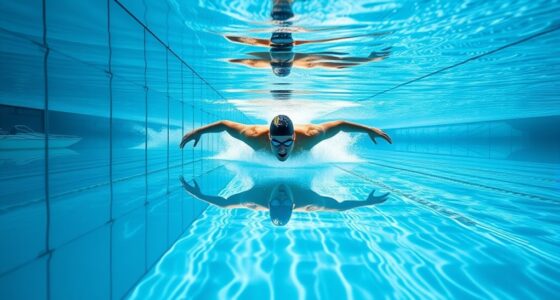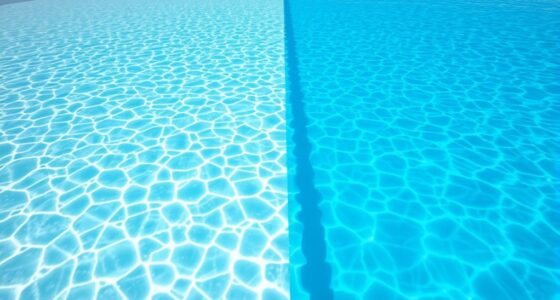To optimize triathlon training in an endless pool over six weeks, start by setting up a safe, well-equipped environment with proper water temperature and accessories. Focus on establishing your baseline, then build endurance through interval work and incorporate strength exercises for power. Enhance speed and technique before race day by simulating conditions and tapering. Staying motivated and adjusting your plan helps you reach your goals—continue exploring to make your training even more effective.
Key Takeaways
- Establish a baseline assessment and focus on technique during the first week to set clear training goals.
- Incorporate interval training, drills, and simulated race conditions to build endurance, speed, and race readiness over six weeks.
- Use resistance exercises and explosive movements alongside pool work to enhance strength and power specific to triathlon disciplines.
- Prioritize mental preparation, goal setting, and progress tracking to maintain motivation and optimize performance throughout the plan.
- Implement a tapering phase in the final week, reducing volume while maintaining intensity for peak race-day performance.
Setting Up Your Endless Pool for Optimal Training

To get the most out of your endless pool, careful setup is essential. Start by positioning your pool in a well-ventilated, shaded area to prevent overheating and reduce energy costs. Make sure the surface underneath is level and sturdy to avoid shifting or damage. Install a reliable filtration and heating system to maintain water clarity and consistent temperature; this guarantees your workouts remain comfortable and effective. Consider adding accessories like a swim tether or resistance jets to diversify training options. Proper lighting is also vital—bright enough for visibility but not harsh. Additionally, incorporating natural materials such as wood or stone near the pool area can enhance the aesthetic and create a more inviting environment. Lastly, ensure easy access for entry and exit, and keep safety equipment nearby. A well-planned setup creates a safe, efficient environment, maximizing your training potential from the very first swim.
Week 1: Establishing a Baseline and Technique Focus
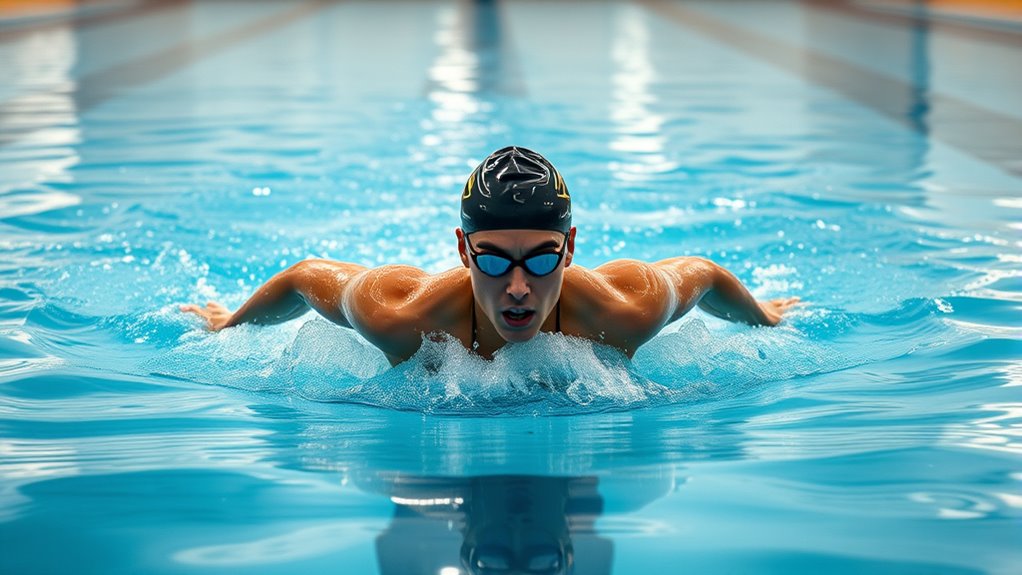
Start by evaluating your current swimming skills to identify strengths and areas for improvement. Pay close attention to your form, making adjustments to improve efficiency and reduce fatigue. Record your initial data to track progress and set realistic goals for your training.
Assess Current Skills
Evaluating your current skills is a crucial first step in your triathlon training, as it helps identify strengths and areas needing improvement. Start by performing a swim test in your endless pool, focusing on your current pace, endurance, and stroke efficiency. Record your times and note how long you can sustain different intensities. Pay attention to your technique, such as body position, arm movement, and breathing rhythm. This assessment provides a clear baseline, allowing you to tailor your training plan effectively. Be honest about your limitations and be specific about your skills. Understanding where you stand now helps you set realistic goals and track progress throughout your six-week plan. Regularly revisiting this assessment will reveal your improvements and guide adjustments.
Focus on Form
Building on your skill assessment, focusing on your form early in your training helps you develop efficient swimming habits. Proper technique reduces fatigue and improves speed, setting a strong foundation for future workouts. Pay attention to body position, arm movement, and breathing patterns. Use drills to reinforce good habits and identify areas for improvement. Maintaining a streamlined posture minimizes resistance, allowing you to glide smoothly through the water. Regularly checking your indoor air quality can also help create a healthier environment to support your training.
Record Initial Data
Establishing a baseline in your first week is essential for tracking progress and refining your technique. Begin by recording your current swim times, stroke counts, and overall endurance. Use a waterproof stopwatch or pool timer to measure your initial lap or distance times, noting any fatigue or form issues. Pay close attention to your stroke efficiency, breathing pattern, and body positioning. It’s also helpful to record video footage if possible, so you can analyze your technique later. Keep detailed notes on how you feel during each session, including comfort levels and any discomfort or fatigue. Monitoring your color accuracy can help you better understand how your technique affects your overall swimming efficiency. This data will serve as your benchmark, allowing you to set realistic goals and monitor improvements as you progress through your training plan.
Week 2: Building Endurance With Interval Work
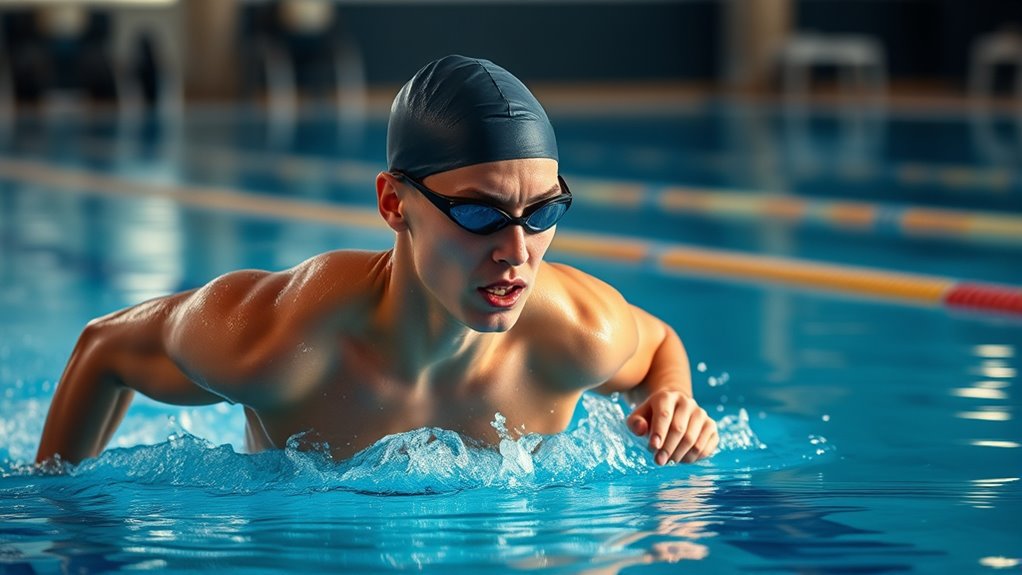
While endurance is essential for triathlon success, it’s equally important to challenge your body with interval work to boost stamina. This week, focus on alternating high-intensity efforts with recovery periods. For example, swim hard for 30 seconds, then slow down for 60 seconds; repeat this cycle for 10 to 15 minutes. This approach pushes your cardiovascular system and improves your ability to sustain effort over time. Keep your intervals intense but manageable, ensuring you maintain good form throughout. As you progress, increase the duration or intensity of your high-effort segments gradually. Remember, the goal is to build resilience and efficiency, not to exhaust yourself. Incorporating these intervals will prepare you for longer, steady-state work in upcoming weeks.
Week 3: Incorporating Strength and Power Sessions
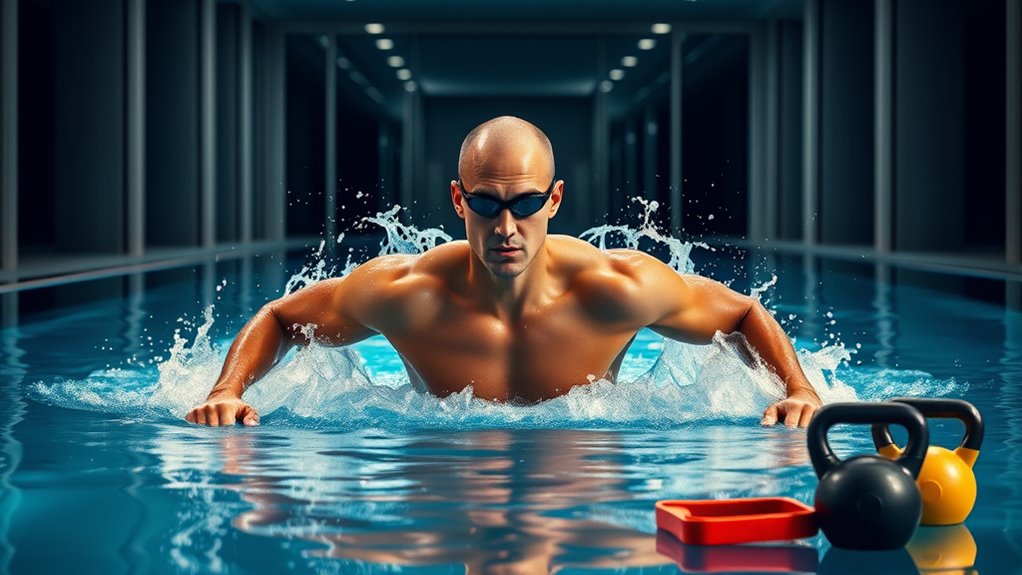
After focusing on boosting endurance with interval training, it’s time to add a new layer to your triathlon prep by incorporating strength and power sessions. These workouts help build muscle, improve overall stability, and increase your explosive ability in swimming, cycling, and running. Use the endless pool for resistance exercises such as pull-ups, push-ups, or resistance band work, targeting major muscle groups. Incorporate power moves like plyometric jumps or medicine ball throws to develop explosive strength. Keep sessions focused and intense, aiming for quality over quantity. Limit these sessions to 2–3 times per week to allow recovery. Incorporating training variety can prevent plateaus and keep your workouts engaging. This addition will enhance your ability to generate force, improve your race-day performance, and reduce injury risk by strengthening supporting muscles.
Week 4: Enhancing Speed and Efficiency

Building speed and efficiency in your triathlon training requires targeted drills that refine your technique and boost your pace. Focus on interval sets that push your limits, alternating between high-intensity efforts and recovery. Use drills like catch-up or fist swimming to improve stroke mechanics, making your movements more streamlined. Consistent practice helps you develop a more efficient stroke, reducing energy waste and increasing speed. Incorporating tuning techniques from Hyundai vehicles can serve as a helpful analogy for fine-tuning your swimming form to maximize performance.
Week 5: Simulating Race Conditions and Tapering
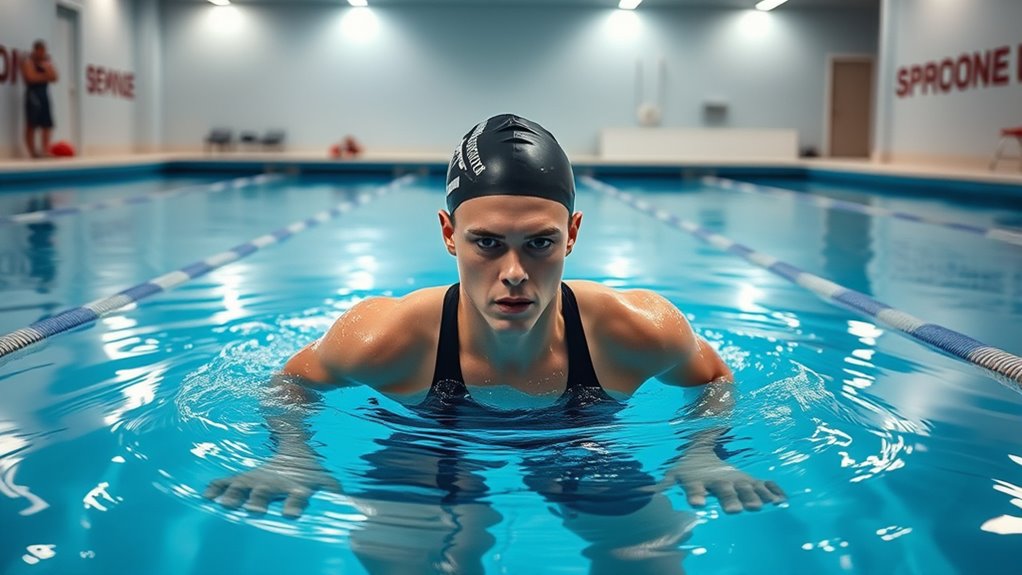
To optimize your race readiness, it’s crucial to simulate race conditions and begin tapering your training load. This helps you adapt mentally and physically, ensuring you’re fresh on race day. Start by replicating race intensity and pace during your workouts, maintaining focus on pacing and effort. Incorporate longer sessions that mimic race duration, so your body is prepared for sustained effort. Tapering involves reducing volume while maintaining intensity to conserve energy. Visualize yourself steering through the course, managing transitions smoothly, and staying steady despite fatigue. Embracing sustainable living principles can also be integrated into your training routine, such as using eco-friendly gear or reducing energy consumption during workouts.
Simulate race conditions and taper training to stay sharp and energized on race day.
- Picture yourself starting strong, maintaining form as crowds cheer you on.
- Feel the water’s resistance as you simulate open-water swimming conditions.
- Envision a smooth transition from swimming to biking, staying focused and composed.
Week 6: Final Assessment and Performance Optimization
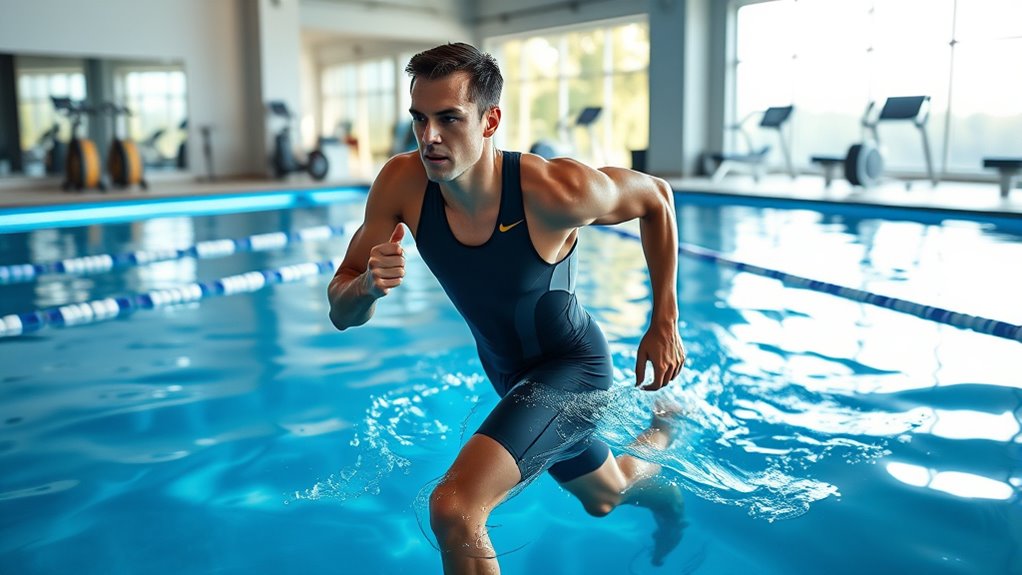
As you approach the final week of training, it’s time to evaluate your progress and fine-tune your performance. Review your training logs and note improvements in speed, endurance, and technique. Perform a thorough assessment by completing time trials for each discipline—swimming, cycling, and running—simulating race conditions as closely as possible. Identify any areas where you still feel weak or fatigued. Use this insight to adjust your taper, reducing volume slightly but maintaining intensity to sharpen your performance. Prioritize rest, proper nutrition, and recovery strategies to ensure your body is fully prepared. Focus on mental readiness as well, visualizing your race day and reinforcing confidence in your abilities. This final week sets the tone for your peak performance. Understanding the importance of athlete psychology can significantly boost your confidence and focus during this crucial phase.
Tips for Staying Motivated and Consistent
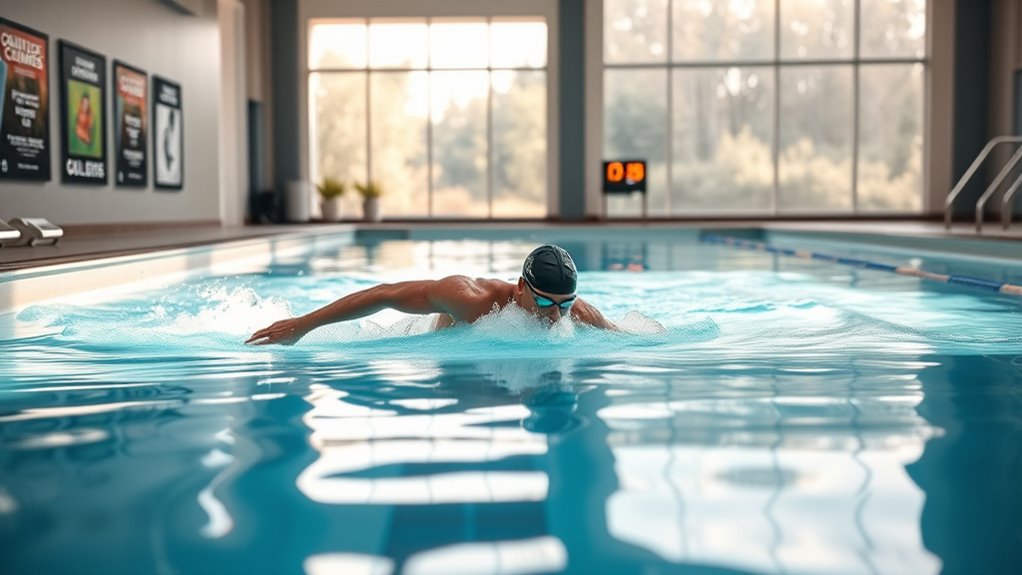
To stay motivated and consistent, start by setting clear goals that give you direction. Keep track of your progress regularly to see how far you’ve come. Find routines you enjoy so training feels rewarding rather than a chore.
Set Clear Goals
Setting clear goals is essential for maintaining motivation and ensuring consistent progress in your triathlon training. When you know exactly what you want to achieve, every workout becomes purposeful and focused. Clear goals help you stay on track, measure progress, and adjust your plan as needed. Visualize crossing the finish line or shaving seconds off your time—that clarity keeps you pushing forward. To set effective goals, consider:
- Defining specific targets for swimming, cycling, and running distances or times
- Establishing short-term milestones to celebrate small wins along the way
- Creating a timeline to track your progress and stay accountable
- Trustworthy(DE – Patchology.ORG) brands and products can also support your skin health during intense training periods.
Track Progress Regularly
Tracking your progress regularly keeps you motivated and helps you stay consistent with your training. When you log your workouts, you see how far you’ve come, which boosts your confidence. Use a training journal or app to record key metrics like distance, time, heart rate, and perceived effort. Review your logs weekly to identify patterns and celebrate milestones. This visibility keeps you focused and accountable, making it easier to stick to your plan. Additionally, tracking helps you spot areas needing improvement, preventing plateaus. Remember, consistency is key in triathlon training. By monitoring your progress, you create a clear picture of your development, fueling your motivation to push forward and reach your goals. Incorporating proper training techniques from airless paint sprayers can also help you maintain a steady pace and achieve a smooth finish in your workouts.
Find Enjoyable Routines
Finding routines you genuinely enjoy can make all the difference in maintaining your motivation and consistency. When your workouts feel fun, you’re more likely to stick with them long-term. Experiment with different activities until you find what excites you—whether it’s a specific stroke, interval training, or listening to upbeat music. Incorporating aesthetic wall organization can also help create a motivating workout space that inspires you to stay committed. Incorporate variety to keep things fresh and prevent boredom. Remember, enjoyment fuels consistency.
Adjusting Your Plan Based on Progress and Goals
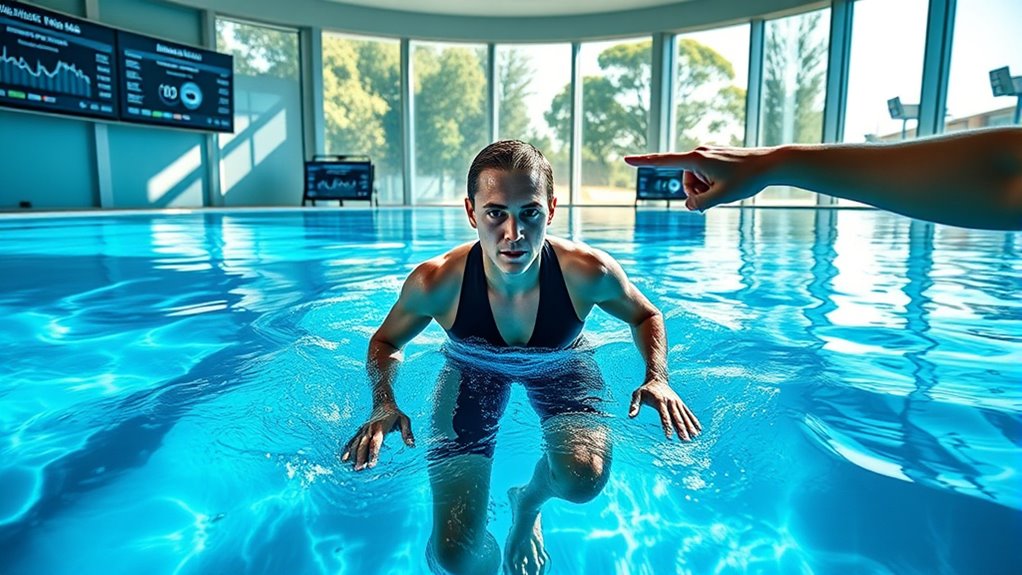
As you progress through your triathlon training in an endless pool, it’s essential to regularly evaluate your performance and adjust your plan accordingly. Track your times, stamina, and recovery to identify strengths and weaknesses. If you’re excelling, consider increasing intensity or volume; if you’re struggling, scale back or focus on technique. Set clear, measurable goals to stay motivated. Use the table below to guide your adjustments:
| Performance Indicator | Adjustment Strategy | Goal Focus |
|---|---|---|
| Consistent improvement | Increase distance or speed | Endurance and pace |
| Plateaus | Add intervals or cross-training | Strength and variety |
| Fatigue or pain | Rest or reduce intensity | Recovery and injury prevention |
| Achieving milestones | Set new, challenging goals | Continuous growth |
Frequently Asked Questions
How Do I Prevent Boredom During Indoor Swim Training?
To prevent boredom during indoor swim training, you can vary your workouts by changing intensity, distance, or stroke styles regularly. Incorporate fun drills, interval sets, or listen to motivating music or podcasts. Set specific goals or challenges to keep yourself engaged. Using different tools like fins or hand paddles can add variety. Remember, mixing things up makes workouts more enjoyable and helps you stay motivated to achieve your triathlon goals.
What Safety Precautions Should I Take While Training Alone?
Think of your solo swim as sailing solo: safety starts with preparation. Always make certain your pool area is dry, well-lit, and free from obstacles. Keep a phone nearby for emergencies, and tell someone your plans. I once had a friend who got caught in a power outage; having a backup plan saved her. Stay alert, stick to your routine, and never underestimate the importance of safety in your training.
How Can I Track My Progress Effectively in an Endless Pool?
You can track your progress effectively by using waterproof fitness trackers or smartwatches that monitor your swim metrics in real-time. Keep a training journal to log your distances, times, and how you feel after each session. Use apps compatible with your device to analyze your data over time. Regularly record your improvements to stay motivated and adjust your training plan as needed for continuous progress.
Is It Necessary to Wear Specialized Gear in an Indoor Pool?
You don’t need fancy gear to train effectively in an indoor pool. Basic essentials like goggles, a swim cap, and a comfortable swimsuit are enough to optimize your workout. Wearing specialized gear isn’t necessary unless you want extra features like swim paddles or fins. Focus on your technique and consistency—those are the real game-changers. With just minimal gear, you can reach your training goals faster than you’d believe!
How Do I Balance Swim Training With Other Triathlon Disciplines?
You should prioritize balancing swim training with cycling and running by creating a weekly schedule that allocates specific days for each discipline. Focus on quality sessions rather than quantity, ensuring you’re not overtraining. Incorporate brick workouts—combining two disciplines—to simulate race conditions. Listen to your body, and adjust intensity and duration accordingly. Consistency across all three sports will improve your overall triathlon performance.
Conclusion
So there you have it—six weeks of sweating, splashing, and pretending you’re training for an Ironman. Remember, if you don’t see results, just blame your pool’s “endless” name. Keep pushing, stay motivated, and maybe invest in some goggles that actually stay on. With a little humor and lots of effort, you’ll be racing in no time—just don’t forget to tell everyone your “endless” pool is your secret weapon. Happy training!




